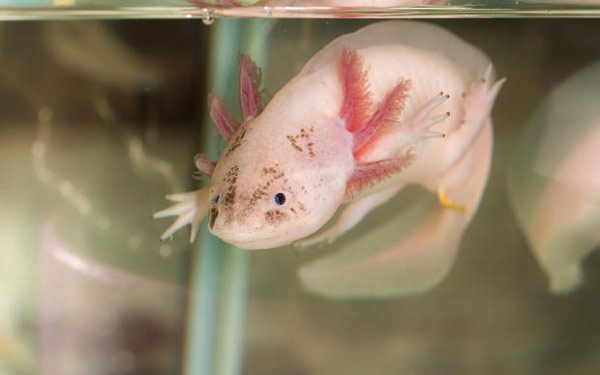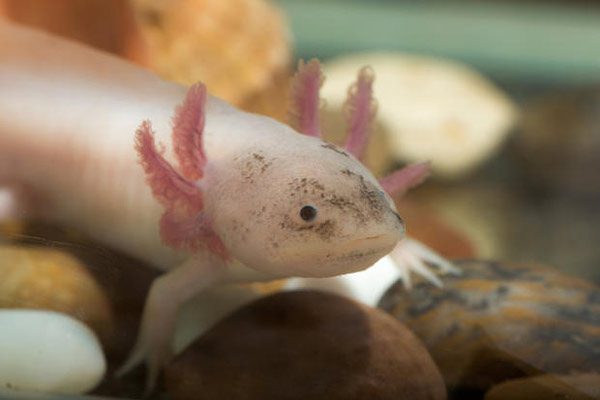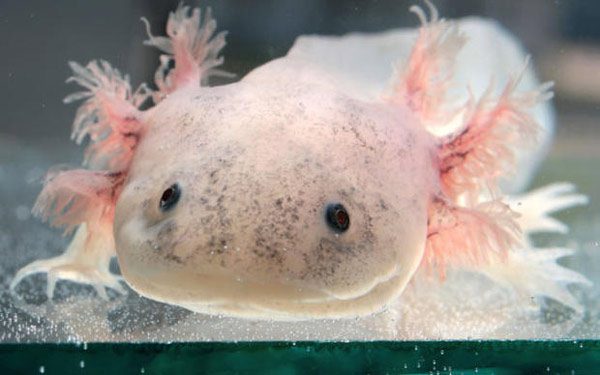The Axolotl, an amphibian unique to Mexico, has the remarkable ability to regenerate most of its body parts, from limbs to eyes, and even parts of its brain.
What is the Axolotl?
The Mexican Axolotl (Axolotl), also known as the “six-horned dinosaur,” is an amphibian that can only be found in two lakes, Xochimilco and Chalco, near Mexico City, and is nearly extinct.

The Axolotl.
Despite its rarity, the extremely cute appearance of the Mexican Axolotl has made it one of the most famous amphibians in the world.
It has inspired characters in the globally renowned Pokémon series from Japan, as well as in video games like Animal Crossing and Minecraft, and has even appeared in a Google Doodle.
The Mexican Axolotl is so beloved that it is the national amphibian of Mexico and appeared on the 50 peso bill released in 2021.
With its cheerful, small face and frilly gills, the Axolotl resembles the amphibian version of a “puppy.” This cuteness is due to the Axolotl’s literal failure to grow up correctly.
Most salamanders undergo metamorphosis from a fully aquatic larval form to a primarily terrestrial adult form.
However, the Axolotl is one of the salamander species that does not develop this way. Instead, it retains all the characteristics of its larval stage – external gills and a dorsal fin – and remains completely aquatic, yet it can reproduce. This phenomenon is known as paedomorphosis or neoteny, which refers to a genetic condition in which an adult retains juvenile characteristics.
Let’s explore some mysteries of the Axolotl below:
1. Axolotl means “water dog”

The scientific name of the Axolotl is Turritopsis Nutricula. The name Axolotl comes from the Mexica language, where atl means “water” and xolotl means “dog.”
The name Axolotl translates to “water dog.” With its strange shape and characteristics, the Axolotl is considered a pet kept for ornamental purposes in homes.
2. Rare white Axolotls
Axolotls typically have brownish-green or black colorations; white specimens are very rare. The white Axolotl is referred to as “leucistic,” the result of a cross with a genetically mutated male imported from France in 1803.
Black Axolotls tend to grow with blue eyes, while white ones usually have red eyes.
3. Invisible hair on its head

The Axolotl’s head usually has hair, but it is very small and short, making it hard to see. It also has soft spikes that assist in metabolic exchange and help it move.
4. Axolotls are no longer found in the wild

You can see Axolotls in aquariums and laboratories around the world, but they cannot be found in the natural world.
They still survive in Lake Xochimilco, Mexico. Axolotls are easy to care for and can eat small fish, worms, and anything close to their mouths.
5. Axolotls are at risk of extinction

Due to pollution, habitat loss, and competition from other aquatic animals, Axolotls are increasingly at risk of extinction, even with their unique ability to regenerate body parts.
To conserve the Axolotl, scientists have built habitats for them using reeds and rocks. However, the number of Axolotls continues to decline.
A 1998 survey estimated that there were about 6,000 wild Axolotls left, and it has become increasingly rare for scientists to find them.
By 2014, biologists reported not finding any. They may have gone extinct in the wild, surviving only in artificial tanks.
6. Axolotls can be eaten
When Axolotls were not at risk of extinction, Mexicans often consumed them with grains. Some have described their taste as similar to that of eel.
Currently, to taste this special dish, one must go to Japan. In Osaka, there is a restaurant specializing in dishes made from Axolotls, especially crispy grilled Axolotl. It tastes similar to white fish but slightly crunchy.
7. Mythology surrounding the Axolotl

In Mexica mythology, the Axolotl is a dog-headed god embodying evil, guiding the souls of the dead to the underworld.
Some stories have been transformed, intertwined with real events. However, it is believed that the dog-headed god transformed into the Axolotl to hide.
This jellyfish-like creature has been trapped in Lake Xochimilco, unable to metamorphose and live on land.
8. Axolotls resemble larvae

Larvae are creatures that do not change characteristics upon reaching maturity. In rare cases, they exhibit juvenile traits in adulthood. The Axolotl is a prime example of larvae.
They grow large but never fully mature. Unlike tadpoles and similar animals, they cling with spikes, living in water despite having well-developed lungs.
9. Axolotls can be induced to mature

A scientist has induced Axolotls to mature by removing them from water. This causes their hormones to spike, resulting in sudden growth. The Axolotl behaves more like a tadpole, but it requires continued separate care.
While Axolotls can change their living habits, biologists advise against this to preserve their species.
10. The Axolotl’s “age-reversing” ability
The Axolotl has the capability to regenerate parts of its body, such as limbs, spinal cord, and even brain tissue without leaving scars, almost like possessing a “age-reversing” power.
You can cut its spinal cord or remove its limbs, and it will perfectly regrow them without leaving any trace. You could cut it 100 times, and it would still regenerate flawlessly.
Scientists have successfully experimented with transplanting parts from one Axolotl to another.
11. Science seeks to decode the Axolotl’s “age-reversing” ability
In 2012, the Salk Institute for Biological Studies published two research papers on the regenerative abilities of Axolotls, hoping to uncover mechanisms that could be applied to humans.
However, the research results indicated that the regeneration process of the Axolotl is more complex than scientists initially thought. They fear humans lack the necessary genes for regeneration.
They continue their research with the hope that it may lead to new treatments for individuals requiring body part replacements in the future.


















































